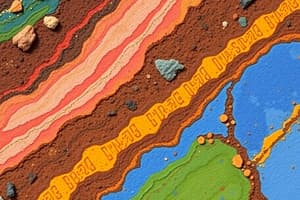Podcast
Questions and Answers
What is Sandy Clay Loam composed of?
What is Sandy Clay Loam composed of?
- 20% Clay, 40% Sand, and 40% Silt
- 35% Clay, 40% Sand, and 35% Silt
- 10% Clay, 30% Sand, and 60% Silt
- 30% Clay, 50% Sand, and 20% Silt (correct)
What is Silt Loam composed of?
What is Silt Loam composed of?
- 20% Clay, 40% Sand, and 40% Silt
- 10% Clay, 20% Sand, and 70% Silt (correct)
- 10% Clay, 30% Sand, and 60% Silt (correct)
- 15% Clay, 70% Sand, and 15% Silt
What is Loam composed of?
What is Loam composed of?
- 33% Clay, 33% Sand, and 33% Silt
- 35% Clay, 40% Sand, and 35% Silt
- 50% Clay, 25% Sand, and 25% Silt
- 20% Clay, 40% Sand, and 40% Silt (correct)
What is Clay Loam composed of?
What is Clay Loam composed of?
What is Clay composed of?
What is Clay composed of?
Which way do you draw the line from Clay?
Which way do you draw the line from Clay?
Which way do you draw the line from Silt?
Which way do you draw the line from Silt?
Which way do you draw your line from Sand?
Which way do you draw your line from Sand?
Flashcards
Sandy Clay Loam composition?
Sandy Clay Loam composition?
30% Clay, 50% Sand, and 20% Silt.
Silt Loam composition?
Silt Loam composition?
10% Clay, 20% Sand, and 70% Silt.
Loam composition?
Loam composition?
20% Clay, 40% Sand, and 40% Silt.
Clay Loam composition?
Clay Loam composition?
Signup and view all the flashcards
Clay composition?
Clay composition?
Signup and view all the flashcards
Line from Clay points...?
Line from Clay points...?
Signup and view all the flashcards
Line from Silt points...?
Line from Silt points...?
Signup and view all the flashcards
Line from Sand points...?
Line from Sand points...?
Signup and view all the flashcards
Study Notes
Soil Types and Compositions
- Sandy Clay Loam: Comprised of 30% clay, 50% sand, and 20% silt; offers good drainage while holding some nutrients.
- Silt Loam: Contains 10% clay, 30% sand, and 60% silt; ideal for agriculture due to its nutrient retention and moisture-holding capacity.
- Loam: Balanced mix of 20% clay, 40% sand, and 40% silt; often considered the ideal soil for gardening and farming due to its fertility.
- Silt Loam: Another variation with 10% clay, 20% sand, and 70% silt; also provides excellent moisture retention.
- Clay Loam: Made up of 35% clay, 40% sand, and 35% silt; retains moisture well but with better drainage than pure clay.
- Clay: Contains 50% clay, 25% sand, and 25% silt; characterized by its heavy texture and low drainage capacity.
- Sandy Loam: Composed of 15% clay, 70% sand, and 15% silt; provides good drainage and air circulation, beneficial for root development.
- Silt Loam: Another version with 15% clay, 15% sand, and 70% silt; high fertility makes it suitable for crop production.
- Clay Loam: An additional mixture with 33% clay, 33% sand, and 33% silt; balances retention and drainage effectively.
- Clay: Another variant, with 70% clay, 20% sand, and 10% silt; very dense and can create compacted layers in the soil profile.
Soil Texture Interpretation
- To Silt: Determine the direction of the line drawn from clay towards silt when interpreting soil texture.
- To Sand: Identify the line's route from silt towards sand for accurate soil classification.
- To Clay: Establish the path from sand back towards clay for proper understanding of soil texture dynamics.
Studying That Suits You
Use AI to generate personalized quizzes and flashcards to suit your learning preferences.



